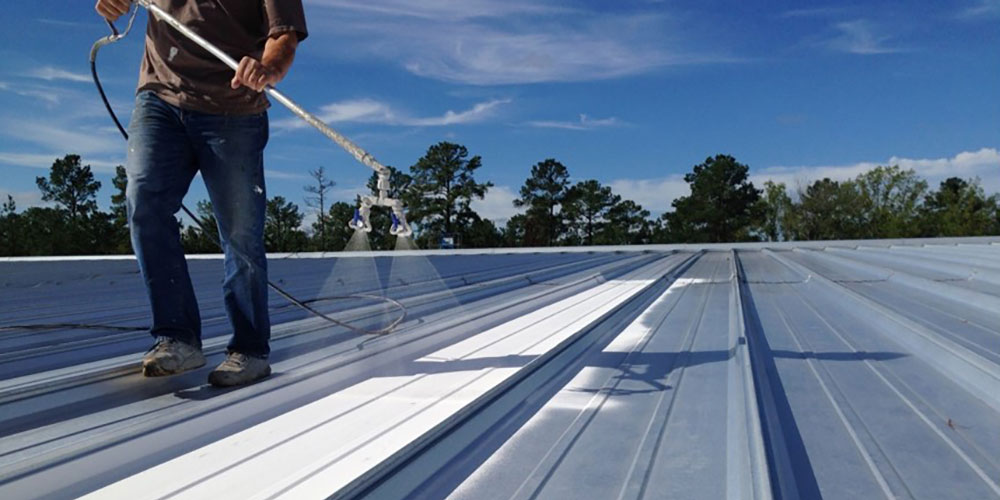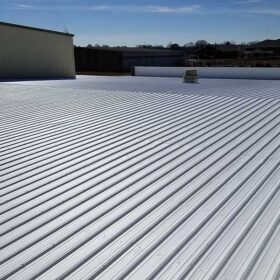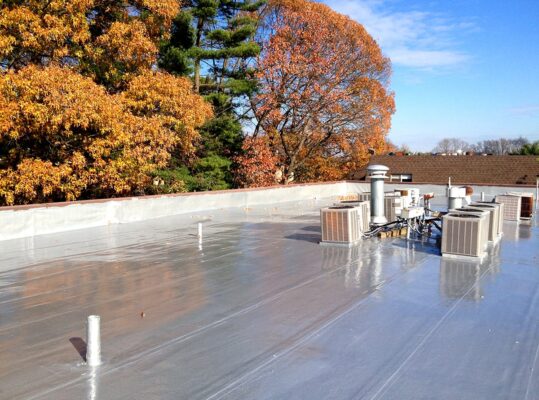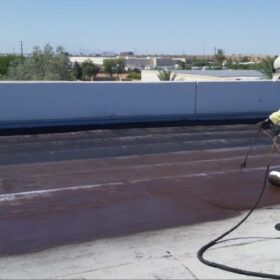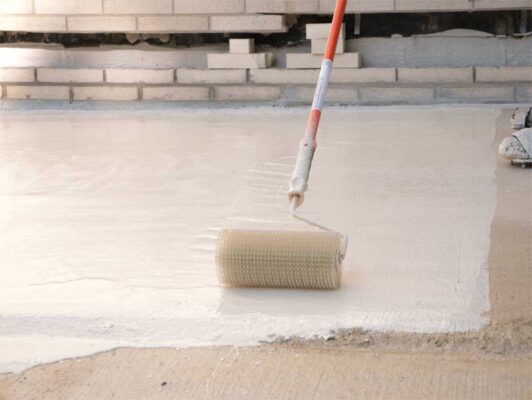Each coating has strengths and trade-offs. The right choice depends on your roof type, ponding water issues, and budget.
1. Silicone Roof Coatings
Best For: Flat and low-slope roofs with ponding water (TPO, PVC, EPDM, BUR, modified bitumen, metal).
Why Texas Businesses Choose It:
-
Superior resistance to standing water
-
Outstanding UV stability (crucial in Texas heat)
-
High solar reflectivity for energy savings
-
Flexible and long-lasting
Considerations:
-
More costly per gallon than acrylic
-
Requires expert prep and priming
-
Dirt pickup possible, requiring periodic cleaning
If ponding water is a problem, silicone is often the #1 choice for commercial roofs in Texas.
2. Acrylic (Elastomeric) Roof Coatings
Best For: Metal roofs, modified bitumen, or flat roofs with good drainage.
Advantages:
-
Budget-friendly installation
-
Highly reflective “cool roof” performance
-
Water-based, easier cleanup
-
Available in multiple colors
Limitations:
-
Not ideal for chronic ponding water
-
Requires more frequent re-coats than silicone
For many buildings, acrylic provides the best balance of cost and performance, especially when water isn’t an issue.
3. Polyurethane / Urethane Roof Coatings
Best For: Roofs with high foot traffic or mechanical equipment zones.
Strengths:
-
Superior tensile strength and impact resistance
-
Great for hail-prone Texas areas
-
Works well on metal and service-heavy roofs
Limitations:
-
Higher upfront cost
-
Odor and fumes during installation
When durability and foot traffic matter, urethane coatings excel.
4. Asphalt Emulsion + Reflective Topcoats
Best For: Aging built-up roofs (BUR) and modified bitumen systems.
Strengths:
-
Very cost-effective rehab option
-
Can embed polyester mats for reinforcement
-
Finished with acrylic or aluminum reflective coatings
Limitations:
-
Requires dry conditions during install
-
Not the best choice for ponding water
This is a budget-friendly solution when replacement isn’t financially feasible.
5. Specialty Liquid Systems (PMMA / PUMA)
Best For: Complex details, penetrations, gutters, and localized high-risk areas.
Strengths:
-
Rapid cure—even in cool weather
-
Highly durable and flexible
-
Ideal for minimizing downtime in retail or healthcare facilities
Limitations:
-
Premium cost
-
Often used in selective areas rather than full roof coverage
Matching Roof Types with the Right Coating
| Roof Type | Best Coating Options |
|---|---|
| TPO / PVC / EPDM | Silicone, urethane, high-build acrylic (good drainage) |
| Modified Bitumen / BUR | Acrylic, asphalt emulsion with reflective topcoat |
| Metal (corrugated, standing seam) | Acrylic, silicone, urethane with rust treatment |
| Spray Polyurethane Foam | Silicone or urethane topcoat |
Not sure which system your roof has? Our Commercial Roof Repair in Austin page explains how we inspect and identify roof types before recommending a solution. You can also read our guide on understanding commercial roofing options like TPO, EPDM, PVC, and modified bitumen to learn more about each system before choosing a coating.
What Makes a Roof Coating Last in Texas
Even the best roof coating can fail if improperly applied. Falcon Roofing follows Texas-tough standards:
-
Inspection & Moisture Scans – detect hidden damage and ensure substrate is dry.
-
Surface Prep – power-wash, prime, treat rust, repair seams.
-
Detail Reinforcement – address penetrations, curbs, term bars, gutters.
-
Multi-Pass Application – roll/spray to manufacturer’s thickness requirements.
-
Final QA & Warranty – adhesion tests, punch lists, and submission for manufacturer warranty.
This same process is detailed in our Commercial Roof Coatings page.
FAQs About Commercial Roof Coatings in Texas
Will a coating stop my leaks?
Yes—if leaks stem from seams, penetrations, or degraded membranes. Structural issues may need repair first.
How long do roof coatings last?
Most last 10–20 years, depending on chemistry and maintenance cycles.
Can any roof be coated?
Single-ply, modified bitumen, BUR, and metal roofs are all candidates—if structurally sound and dry.
What about ponding water?
Silicone coatings perform best in ponding-prone conditions common on Texas roofs.
How quickly can work begin?
Many projects start within days of inspection, weather permitting.
When NOT to Use a Roof Coating
-
Membrane is saturated or failing
-
Structural damage exists under the deck
-
Roof has exceeded its serviceable life
-
Drainage cannot be corrected
In those cases, a full commercial roof replacement may be the best option.
Final Thoughts: Choosing the Right Roof Coating in Texas
Roof coatings are one of the most effective ways to extend roof life, cut cooling costs, and stop leaks—without the expense of a tear-off. But success depends on the right chemistry, proper prep, and expert installation.
If you’re ready to explore whether a coating is the right choice, contact Falcon Roofing & Restoration for a free inspection and roof assessment today. We’ll compare repair vs. restoration vs. replacement so you can make the best decision for your building.
Schedule Your Free Roof Inspection →



